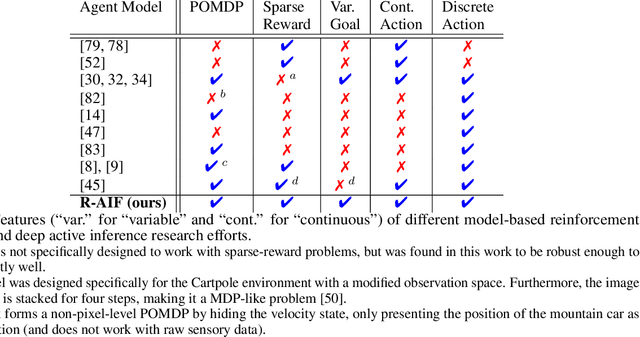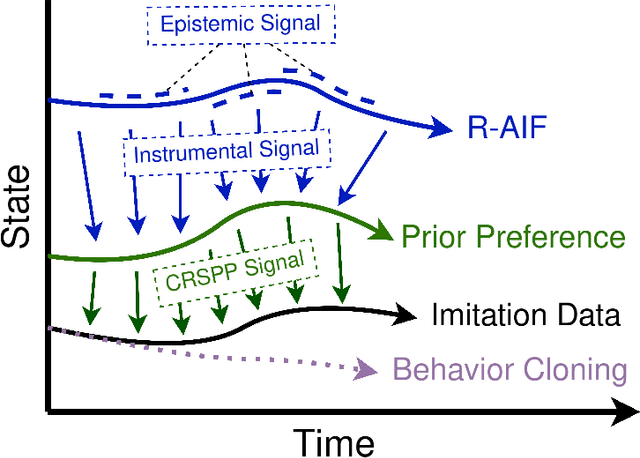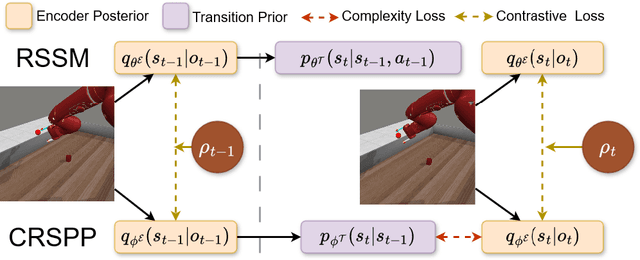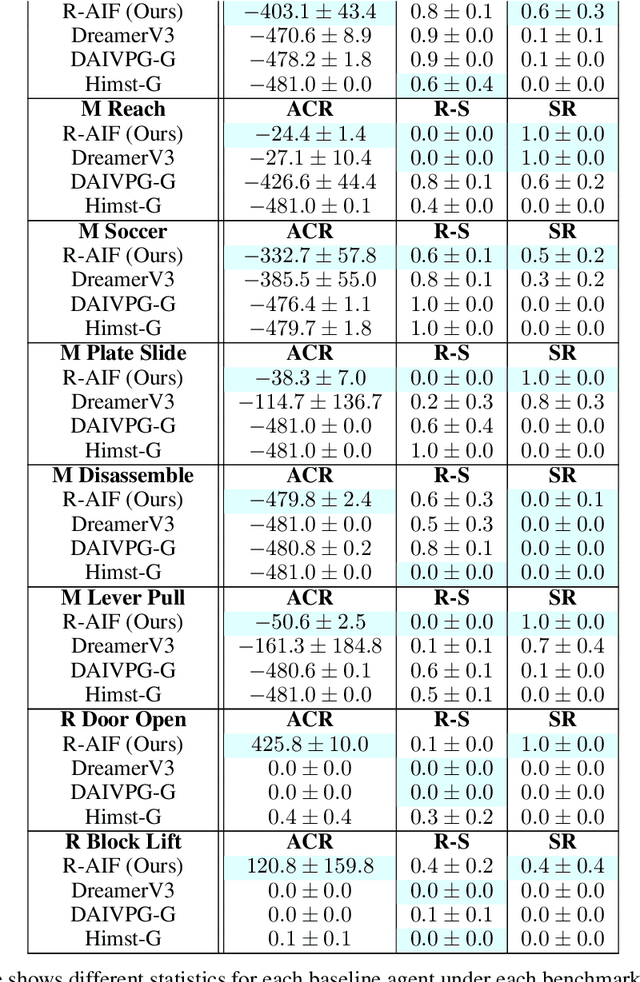Alexander Ororbia
Class Incremental Continual Learning with Self-Organizing Maps and Variational Autoencoders Using Synthetic Replay
Aug 28, 2025Abstract:This work introduces a novel generative continual learning framework based on self-organizing maps (SOMs) and variational autoencoders (VAEs) to enable memory-efficient replay, eliminating the need to store raw data samples or task labels. For high-dimensional input spaces, such as of CIFAR-10 and CIFAR-100, we design a scheme where the SOM operates over the latent space learned by a VAE, whereas, for lower-dimensional inputs, such as those found in MNIST and FashionMNIST, the SOM operates in a standalone fashion. Our method stores a running mean, variance, and covariance for each SOM unit, from which synthetic samples are then generated during future learning iterations. For the VAE-based method, generated samples are then fed through the decoder to then be used in subsequent replay. Experimental results on standard class-incremental benchmarks show that our approach performs competitively with state-of-the-art memory-based methods and outperforms memory-free methods, notably improving over best state-of-the-art single class incremental performance on CIFAR-10 and CIFAR-100 by nearly $10$\% and $7$\%, respectively. Our methodology further facilitates easy visualization of the learning process and can also be utilized as a generative model post-training. Results show our method's capability as a scalable, task-label-free, and memory-efficient solution for continual learning.
Extending Spike-Timing Dependent Plasticity to Learning Synaptic Delays
Jun 17, 2025Abstract:Synaptic delays play a crucial role in biological neuronal networks, where their modulation has been observed in mammalian learning processes. In the realm of neuromorphic computing, although spiking neural networks (SNNs) aim to emulate biology more closely than traditional artificial neural networks do, synaptic delays are rarely incorporated into their simulation. We introduce a novel learning rule for simultaneously learning synaptic connection strengths and delays, by extending spike-timing dependent plasticity (STDP), a Hebbian method commonly used for learning synaptic weights. We validate our approach by extending a widely-used SNN model for classification trained with unsupervised learning. Then we demonstrate the effectiveness of our new method by comparing it against another existing methods for co-learning synaptic weights and delays as well as against STDP without synaptic delays. Results demonstrate that our proposed method consistently achieves superior performance across a variety of test scenarios. Furthermore, our experimental results yield insight into the interplay between synaptic efficacy and delay.
Avoiding Death through Fear Intrinsic Conditioning
Jun 05, 2025Abstract:Biological and psychological concepts have inspired reinforcement learning algorithms to create new complex behaviors that expand agents' capacity. These behaviors can be seen in the rise of techniques like goal decomposition, curriculum, and intrinsic rewards, which have paved the way for these complex behaviors. One limitation in evaluating these methods is the requirement for engineered extrinsic for realistic environments. A central challenge in engineering the necessary reward function(s) comes from these environments containing states that carry high negative rewards, but provide no feedback to the agent. Death is one such stimuli that fails to provide direct feedback to the agent. In this work, we introduce an intrinsic reward function inspired by early amygdala development and produce this intrinsic reward through a novel memory-augmented neural network (MANN) architecture. We show how this intrinsic motivation serves to deter exploration of terminal states and results in avoidance behavior similar to fear conditioning observed in animals. Furthermore, we demonstrate how modifying a threshold where the fear response is active produces a range of behaviors that are described under the paradigm of general anxiety disorders (GADs). We demonstrate this behavior in the Miniworld Sidewalk environment, which provides a partially observable Markov decision process (POMDP) and a sparse reward with a non-descriptive terminal condition, i.e., death. In effect, this study results in a biologically-inspired neural architecture and framework for fear conditioning paradigms; we empirically demonstrate avoidance behavior in a constructed agent that is able to solve environments with non-descriptive terminal conditions.
Tight Stability, Convergence, and Robustness Bounds for Predictive Coding Networks
Oct 07, 2024



Abstract:Energy-based learning algorithms, such as predictive coding (PC), have garnered significant attention in the machine learning community due to their theoretical properties, such as local operations and biologically plausible mechanisms for error correction. In this work, we rigorously analyze the stability, robustness, and convergence of PC through the lens of dynamical systems theory. We show that, first, PC is Lyapunov stable under mild assumptions on its loss and residual energy functions, which implies intrinsic robustness to small random perturbations due to its well-defined energy-minimizing dynamics. Second, we formally establish that the PC updates approximate quasi-Newton methods by incorporating higher-order curvature information, which makes them more stable and able to converge with fewer iterations compared to models trained via backpropagation (BP). Furthermore, using this dynamical framework, we provide new theoretical bounds on the similarity between PC and other algorithms, i.e., BP and target propagation (TP), by precisely characterizing the role of higher-order derivatives. These bounds, derived through detailed analysis of the Hessian structures, show that PC is significantly closer to quasi-Newton updates than TP, providing a deeper understanding of the stability and efficiency of PC compared to conventional learning methods.
R-AIF: Solving Sparse-Reward Robotic Tasks from Pixels with Active Inference and World Models
Sep 21, 2024



Abstract:Although research has produced promising results demonstrating the utility of active inference (AIF) in Markov decision processes (MDPs), there is relatively less work that builds AIF models in the context of environments and problems that take the form of partially observable Markov decision processes (POMDPs). In POMDP scenarios, the agent must infer the unobserved environmental state from raw sensory observations, e.g., pixels in an image. Additionally, less work exists in examining the most difficult form of POMDP-centered control: continuous action space POMDPs under sparse reward signals. In this work, we address issues facing the AIF modeling paradigm by introducing novel prior preference learning techniques and self-revision schedules to help the agent excel in sparse-reward, continuous action, goal-based robotic control POMDP environments. Empirically, we show that our agents offer improved performance over state-of-the-art models in terms of cumulative rewards, relative stability, and success rate. The code in support of this work can be found at https://github.com/NACLab/robust-active-inference.
Contrastive Learning in Memristor-based Neuromorphic Systems
Sep 17, 2024



Abstract:Spiking neural networks, the third generation of artificial neural networks, have become an important family of neuron-based models that sidestep many of the key limitations facing modern-day backpropagation-trained deep networks, including their high energy inefficiency and long-criticized biological implausibility. In this work, we design and investigate a proof-of-concept instantiation of contrastive-signal-dependent plasticity (CSDP), a neuromorphic form of forward-forward-based, backpropagation-free learning. Our experimental simulations demonstrate that a hardware implementation of CSDP is capable of learning simple logic functions without the need to resort to complex gradient calculations.
Deep Domain Adaptation: A Sim2Real Neural Approach for Improving Eye-Tracking Systems
Mar 23, 2024Abstract:Eye image segmentation is a critical step in eye tracking that has great influence over the final gaze estimate. Segmentation models trained using supervised machine learning can excel at this task, their effectiveness is determined by the degree of overlap between the narrow distributions of image properties defined by the target dataset and highly specific training datasets, of which there are few. Attempts to broaden the distribution of existing eye image datasets through the inclusion of synthetic eye images have found that a model trained on synthetic images will often fail to generalize back to real-world eye images. In remedy, we use dimensionality-reduction techniques to measure the overlap between the target eye images and synthetic training data, and to prune the training dataset in a manner that maximizes distribution overlap. We demonstrate that our methods result in robust, improved performance when tackling the discrepancy between simulation and real-world data samples.
Neuro-mimetic Task-free Unsupervised Online Learning with Continual Self-Organizing Maps
Feb 19, 2024Abstract:An intelligent system capable of continual learning is one that can process and extract knowledge from potentially infinitely long streams of pattern vectors. The major challenge that makes crafting such a system difficult is known as catastrophic forgetting - an agent, such as one based on artificial neural networks (ANNs), struggles to retain previously acquired knowledge when learning from new samples. Furthermore, ensuring that knowledge is preserved for previous tasks becomes more challenging when input is not supplemented with task boundary information. Although forgetting in the context of ANNs has been studied extensively, there still exists far less work investigating it in terms of unsupervised architectures such as the venerable self-organizing map (SOM), a neural model often used in clustering and dimensionality reduction. While the internal mechanisms of SOMs could, in principle, yield sparse representations that improve memory retention, we observe that, when a fixed-size SOM processes continuous data streams, it experiences concept drift. In light of this, we propose a generalization of the SOM, the continual SOM (CSOM), which is capable of online unsupervised learning under a low memory budget. Our results, on benchmarks including MNIST, Kuzushiji-MNIST, and Fashion-MNIST, show almost a two times increase in accuracy, and CIFAR-10 demonstrates a state-of-the-art result when tested on (online) unsupervised class incremental learning setting.
Minimally Supervised Learning using Topological Projections in Self-Organizing Maps
Jan 12, 2024



Abstract:Parameter prediction is essential for many applications, facilitating insightful interpretation and decision-making. However, in many real life domains, such as power systems, medicine, and engineering, it can be very expensive to acquire ground truth labels for certain datasets as they may require extensive and expensive laboratory testing. In this work, we introduce a semi-supervised learning approach based on topological projections in self-organizing maps (SOMs), which significantly reduces the required number of labeled data points to perform parameter prediction, effectively exploiting information contained in large unlabeled datasets. Our proposed method first trains SOMs on unlabeled data and then a minimal number of available labeled data points are ultimately assigned to key best matching units (BMU). The values estimated for newly-encountered data points are computed utilizing the average of the $n$ closest labeled data points in the SOM's U-matrix in tandem with a topological shortest path distance calculation scheme. Our results indicate that the proposed semi-supervised model significantly outperforms traditional regression techniques, including linear and polynomial regression, Gaussian process regression, K-nearest neighbors, as well as various deep neural network models.
A Neuro-Mimetic Realization of the Common Model of Cognition via Hebbian Learning and Free Energy Minimization
Oct 14, 2023



Abstract:Over the last few years, large neural generative models, capable of synthesizing intricate sequences of words or producing complex image patterns, have recently emerged as a popular representation of what has come to be known as "generative artificial intelligence" (generative AI). Beyond opening the door to new opportunities as well as challenges for the domain of statistical machine learning, the rising popularity of generative AI brings with it interesting questions for Cognitive Science, which seeks to discover the nature of the processes that underpin minds and brains as well as to understand how such functionality might be acquired and instantiated in biological (or artificial) substrate. With this goal in mind, we argue that a promising long-term pathway lies in the crafting of cognitive architectures, a long-standing tradition of the field, cast fundamentally in terms of neuro-mimetic generative building blocks. Concretely, we discuss the COGnitive Neural GENerative system, which is an architecture that casts the Common Model of Cognition in terms of Hebbian adaptation operating in service of optimizing a variational free energy functional.
 Add to Chrome
Add to Chrome Add to Firefox
Add to Firefox Add to Edge
Add to Edge